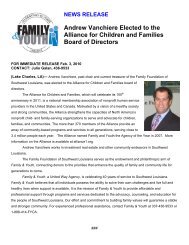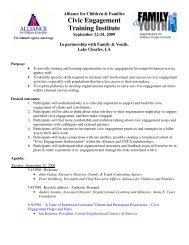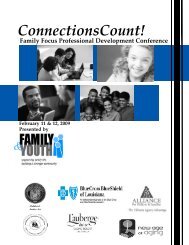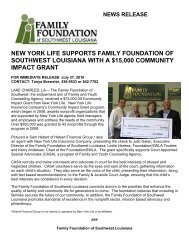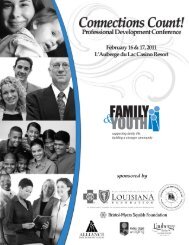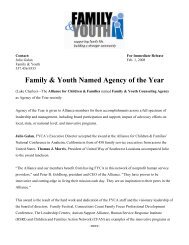Mission-based Advocacy Toolkit from Alliance for Children & Families
Mission-based Advocacy Toolkit from Alliance for Children & Families
Mission-based Advocacy Toolkit from Alliance for Children & Families
You also want an ePaper? Increase the reach of your titles
YUMPU automatically turns print PDFs into web optimized ePapers that Google loves.
Part II: Addressing Common Barriers<br />
on the topic; include the notion in Site Visits and other contacts with decision-makers;<br />
make education on the notion part of all goals – short and long-term.<br />
BARRIER 2: Changes in Funding Strategies<br />
Focus group participants cited changes in funding strategies, particularly <strong>from</strong> United<br />
Way, that reduce support <strong>for</strong> advocacy. In the past, unrestricted United Way funds could<br />
be used to support advocacy. Now, increasingly, they must be directed to priorities set by<br />
United Way and tracked by measurable outcomes – something hard <strong>for</strong> policy advocacy<br />
ef<strong>for</strong>ts to do.<br />
There is no magic bullet <strong>for</strong> penetrating this barrier, but there may be some consolation<br />
in knowing that the United Way – a strong proponent - acknowledges the difficulty of<br />
applying “outcomes measurement” to advocacy (see Barrier 4). That said, there are a<br />
few practical steps you can take to help move your agency in a useful direction.<br />
Easy: If you don’t already, include in every grant application a request that others<br />
“invest in your mission” by (insert your specific request).<br />
Identify the specific components of your advocacy activities that are appealing to<br />
funders. For example, community education is a widely accepted <strong>for</strong>m of advocacy, and<br />
an essential element of mission-<strong>based</strong> advocacy. It is how we help others to understand<br />
what agency clients are facing, how we confront stereotypes, and promote in<strong>for</strong>med<br />
public policy. Similarly, helping individual children and families obtain the services they<br />
need is case advocacy, and central to the <strong>Alliance</strong> mission. Labeling these as the<br />
advocacy activities they are can help open a dialogue with funders about advocacy – and<br />
may offer opportunities to build in support <strong>for</strong> other <strong>for</strong>ms of advocacy in your grant<br />
applications.<br />
Tap higher education resources in your community. Ask faculty at a local university or<br />
community college (e.g., someone teaching a non-profit management course or business<br />
class) to have students calculate the “ROI” (Return On Investment) of resources<br />
committed to policy advocacy, and the “multiplier effect” of human services dollars that<br />
come into a community thanks to public policy advocacy. Use both in explaining the<br />
effectiveness of advocacy work to potential donors – including the United Way. Along<br />
the way, the students will become better in<strong>for</strong>med about the role non-profits play in local<br />
economies, and you will have a credible document to use with legislators and donors<br />
alike.<br />
Graduate students in professional schools (e.g., child development, nursing, public<br />
health, public affairs, social work) often do theses or major projects. With a little<br />
guidance, they might develop a plan <strong>for</strong> increasing the involvement of your board and<br />
volunteers in a long-term public policy objective – like expanding child health coverage<br />
or a community’s stock of af<strong>for</strong>dable housing, or provide background papers <strong>for</strong> a<br />
mission-related strategy you’re embarking on. Since students in these fields tend to<br />
14<br />
© January 2006 The <strong>Alliance</strong> <strong>for</strong> <strong>Children</strong> and <strong>Families</strong>




